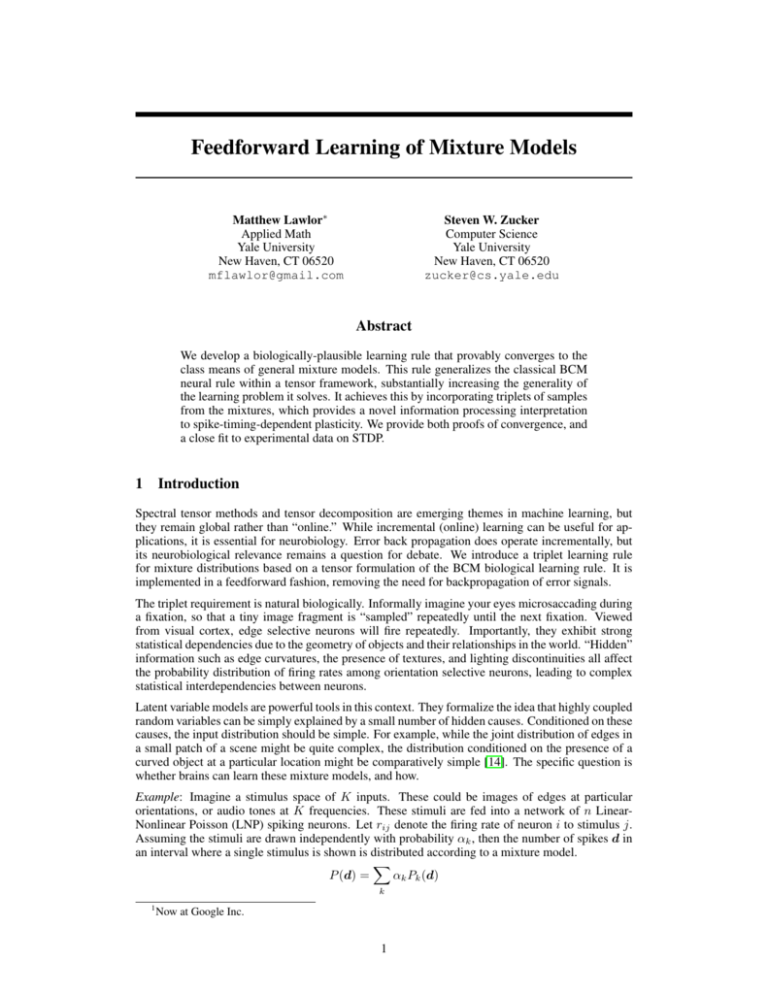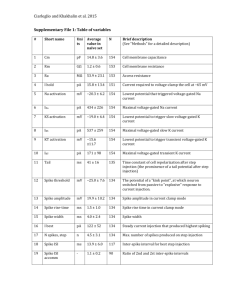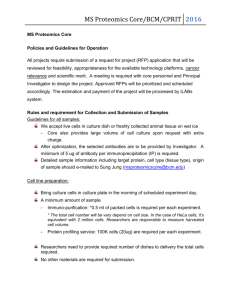Feedforward Learning of Mixture Models
advertisement

Feedforward Learning of Mixture Models
Matthew Lawlor∗
Applied Math
Yale University
New Haven, CT 06520
mflawlor@gmail.com
Steven W. Zucker
Computer Science
Yale University
New Haven, CT 06520
zucker@cs.yale.edu
Abstract
We develop a biologically-plausible learning rule that provably converges to the
class means of general mixture models. This rule generalizes the classical BCM
neural rule within a tensor framework, substantially increasing the generality of
the learning problem it solves. It achieves this by incorporating triplets of samples
from the mixtures, which provides a novel information processing interpretation
to spike-timing-dependent plasticity. We provide both proofs of convergence, and
a close fit to experimental data on STDP.
1
Introduction
Spectral tensor methods and tensor decomposition are emerging themes in machine learning, but
they remain global rather than “online.” While incremental (online) learning can be useful for applications, it is essential for neurobiology. Error back propagation does operate incrementally, but
its neurobiological relevance remains a question for debate. We introduce a triplet learning rule
for mixture distributions based on a tensor formulation of the BCM biological learning rule. It is
implemented in a feedforward fashion, removing the need for backpropagation of error signals.
The triplet requirement is natural biologically. Informally imagine your eyes microsaccading during
a fixation, so that a tiny image fragment is “sampled” repeatedly until the next fixation. Viewed
from visual cortex, edge selective neurons will fire repeatedly. Importantly, they exhibit strong
statistical dependencies due to the geometry of objects and their relationships in the world. “Hidden”
information such as edge curvatures, the presence of textures, and lighting discontinuities all affect
the probability distribution of firing rates among orientation selective neurons, leading to complex
statistical interdependencies between neurons.
Latent variable models are powerful tools in this context. They formalize the idea that highly coupled
random variables can be simply explained by a small number of hidden causes. Conditioned on these
causes, the input distribution should be simple. For example, while the joint distribution of edges in
a small patch of a scene might be quite complex, the distribution conditioned on the presence of a
curved object at a particular location might be comparatively simple [14]. The specific question is
whether brains can learn these mixture models, and how.
Example: Imagine a stimulus space of K inputs. These could be images of edges at particular
orientations, or audio tones at K frequencies. These stimuli are fed into a network of n LinearNonlinear Poisson (LNP) spiking neurons. Let rij denote the firing rate of neuron i to stimulus j.
Assuming the stimuli are drawn independently with probability αk , then the number of spikes d in
an interval where a single stimulus is shown is distributed according to a mixture model.
X
P (d) =
αk Pk (d)
k
1
Now at Google Inc.
1
where Pk (d) is a vector of independent Poisson distributions, and the rate parameter of the ith
component is rik . We seek a filter that responds (in expectation) to one and only one stimulus. To
do this, we must learn a set of weights that are orthogonal to all but one of the vectors of rates r ·j .
Each rate vector corresponds to the mean of one of the mixtures. Our problem is thus to learn the
means of mixtures. We will demonstrate that this can be done non-parametrically over a broad class
of firing patterns, not just Poisson spiking neurons.
Although fitting mixture models can be exponentially hard, under a certain multiview assumption,
non-parametric estimation of mixture means can be done by tensor decomposition [2][1]. This
multiview assumption requires access to at least 3 independent copies of the samples; i.e., multiple
samples drawn from the same mixture component. For the LNP example above, this multiview
assumption requires only that we have access to the number of spikes in three disjoint intervals,
while the stimulus remains constant. After these intervals, the stimulus is free to change – in vision,
say, after a saccade – after which point another sample triple is taken.
Our main result is that, with a slight modification of classical Bienenstock-Cooper-Munro [5] synaptic update rule a neuron can perform a tensor decomposition of the input data. By incorporating the
interactions between input triplets, our online learning rule can provably learn the mixture means
under an extremely broad class of mixture distributions and noise models. (The classical BCM
learning rule will not converge properly in the presence of noise.) Specifically we show how the
classical BCM neuron performs gradient ascent in a tensor objective function, when the data consists of discrete input vectors, and how our modified rule converges when the data are drawn from a
general mixture model.
The multiview requirement has an intriguing implication for neuroscience. Since spikes arrive in
waves, and spike trains matter for learning [9], our model suggests that the waves of spikes arriving during adjacent epochs in time provide multiple samples of a given stimulus. This provides an
unusual information processing interpretation for the functional role of spike trains. To realize it
fully, we point out that classical BCM can be implemented via spike timing dependent plasticity
[17][10][6][18]. However, most of these approaches require much stronger distributional assumptions on the input data (generally Poisson), or learn a much simpler decomposition of the data than
our algorithm. Other, Bayesian methods [16], require the computation of a posterior distribution
which requires an implausible normalization step. Our learning rule successfully avoids these issues, and has provable guarantees of convergence to the true mixture means. At the end of this
paper we show how our rule predicts pair and triple spike timing dependent plasticity data.
2
Tensor Notation
Let ⊗ denote the tensor product. We denote application of a k-tensor to k vectors by T (w1 , ..., wk ),
so in the simple case where T = v 1 ⊗ ... ⊗ v k ,
Y
T (w1 , ..., wk ) =
hv j , wj i
j
We further denote the application of a k-tensor to k matrices by T (M1 , ..., Mk ) where
X
T (M1 , ..., Mk )i1 ,...,ik =
Tj1 ,...,jk [M1 ]j1 ,i1 ...[Mk ]jk ,ik
j1 ,...,jk
Thus if T is a symmetric 2-tensor, T (M1 , M2 ) = M1T T M2 with ordinary matrix multiplication.
Similarly, T (v 1 , v 2 ) = v T1 T v 2 .
We say that T has an orthogonal tensor decomposition if
X
T =
αk v k ⊗ v k ⊗ ... ⊗ v k and hv i , v j i = δij
k
3
Connection Between BCM Neuron and Tensor Decompositions
The BCM learning rule was introduced in 1982 in part to correct failings of the classical Hebbian
learning rule [5]. The Hebbian learning rule [11] is one of the simplest and oldest learning rules. It
2
posits that the selectivity of a neuron to input i, mt (i) is increased in proportion to the post-synaptic
activity of that neuron ct = hmt−1 , dt i, where m is a vector of synaptic weights.
mt − mt−1 = γt ct dt
This learning rule will become increasingly correlated with its input. As formulated this rule does
not converge for most input, as kmk → ∞. In addition, in the presence of multiple inputs Hebbian
learning rule will always converge to an “average” of the inputs, rather than becoming selective to
one particular input. It is possible to choose a normalization of m such that m will converge to
the first eigenvector of the input data. The BCM rule tries to correct for the lack of selectivity, and
for the stabilization problems. Like the Hebbian learning rule, it always updates its weights in the
direction of the input, however it also has a sliding threshold that controls the magnitude and sign of
this weight update.
The original formulation of the BCM rule is as follows: Let c be the post-synaptic firing rate, d ∈ RN
be the vector of presynaptic firing rates, and m be the vector of synaptic weights. Then the BCM
synaptic modification rule is
c = hm, di
ṁ = φ(c, θ)d
φ is a non-linear function of the firing rate, and θ is a sliding threshold that increases as a superlinear
function of the average firing rate.
There are many different formulations of the BCM rule. The primary features that are required are
φ(c, θ) is convex in c, φ(0, θ) = 0, φ(θ, θ) = 0, and θ is a super-linear function of E[c].
These properties guarantee that the BCM learning rule will not grow without bound. There have
been many variants of this rule. One of the most theoretically well analyzed variants is the Intrator
and Cooper model [12], which has the following form for φ and θ.
φ(c, θ) = c(c − θ) with θ = E[c2 ]
Definition 3.1 (BCM Update Rule). With the Intrator and Cooper definition, the BCM rule is defined
as
mt = mt−1 + γt ct (ct − θt−1 )dt
(1)
2
where
ct = hmt−1
P
P, dt i2 and θ = E[c ]. γt is a sequence of positive step sizes with the property that
γ
→
∞
and
<
∞
γ
t t
t t
The traditional application of this rule is a system where the input d is drawn from linearly independent vectors {d1 , ..., dk } with probabilities α1 , ..., αK , with K = N , the dimension of the
space.
These choices are quite convenient because they lead to the following objective function formulation
of the synaptic update rule.
R(m) =
i 1 h
i2
1 h
3
2
E hm, di − E hm, di
3
4
Thus,
h
i
2
2
∇R = E hm, di d − E[hm, di ] hm, di d
= E[c(c − θ)d]
= E[φ(c, θ)d]
So in expectation, the BCM rule performs a gradient ascent in R(m). For random, discrete input
this rule would then be a form of stochastic gradient ascent.
With this model, we observe that the objective function can be rewritten in tensor notation. Note
that this input model can be seen as a kind of degenerate mixture model.
3
This objective function can be written as a tensor objective function, by noting the following:
X
T =
αk dk ⊗ dk ⊗ dk
k
M=
X
k
R(m) =
αk dk ⊗ dk
1
1
T (m, m, m) − M (m, m)2
3
4
(2)
For completeness, we present a proof that the stable points of the expected BCM update are selective
for only one of the data vectors.
The stable points of the expected update occur when E[ṁ] = 0. Let ck = hm, dk i and φk =
φ(ck , θ). Let c = [c1 , . . . , cK ]T and Φ = [φ1 , . . . , φK ]T .
DT = [d1 | · · · |dK ]
P = diag(α)
Theorem 3.2. (Intrator 1992) Let K = N , let each dk be linearly independent, and let αk > 0 and
distinct. Then stable points (in the sense of Lyapunov) of the expected update ṁ = ∇R occur when
c = αk−1 ek or m = αk−1 D−1 ek . ek is the unit basis vector, so there is activity for only one stimuli.
P
Proof. E[ṁ] = DT P Φ which is 0 only when Φ = 0. Note θ = k αk c2k . φk = 0 if ck = 0 or
ck = θ. Let S+ = {k : ck 6= 0}, and S− = {k : ck = 0}. Then for all k ∈ S+ , ck = βS+
−1
X
X
βS+ − βS2 +
αi = 0
βS+ =
αi
k∈S+
k∈S+
Therefore the solutions of the BCM learning rule are c = 1S+ βS+ , for all subsets S+ ⊂ {1, . . . , K}.
We now need to check which solutions are stable. The stable points (in the sense of Lyapunov) are
points where the matrix
∂Φ ∂c
∂Φ
∂E[ṁ]
T
T
=D P
=D P
D
H=
∂m
∂c ∂m
∂c
is negative semidefinite.
Let S be an index set S ⊂ {1, . . . , n}. We will use the following notation for the diagonal matrix
IS :
1 i∈S
(IS )ii =
(3)
0 i∈
/S
So IS + IS c = I, and ei eTi = I{i}
a quick calculation shows
∂φi
= βS+ IS+ − βS+ IS− − 2βS2 + diag(α) 1S+ 1TS+
∂cj
This is negative semidefinite iff A = IS+ − 2βS+ diag(α) 1S+ 1TS+ is negative semidefinite.
Assuming a non-degeneracy of the probabilities α, and assume |S+ | > 1. Let j = arg mink∈S+ αk .
Then βS+ αj < 12 so A is not negative semi-definite. However, if |S+ | = 1 then A = −IS+ so the
stable points occur when c = α1i ei
The triplet version of BCM can be viewed as a modification of the classical BCM rule which allows
it to converge in the presence of zero-mean noise. This indicates that the stable solutions of this
learning rule are selective for only one data vector, dk .
Building off of the work of [2] we will use this characterization of the objective function to build a
triplet BCM update rule which will converge for general mixtures, not just discrete data points.
4
hm1,di
Noise sensitivity of m after 10e6 steps
14
12
10
Triplet Rule
BCM
3
8
6
d1
4
2
0
−10
−5
0
5
10
15
20
km − m0 k
2
m1
25
hm2,di
m2
22
1
20
18
d2
16
14
12
10
0
8
6
10−2
4
2
0
−10
−5
0
5
10
15
20
100
101
Noise σ
(a) Geometry of stable solutions. Each stable
solution is selective in expectation for a single
mixture. Note that the classical BCM rule will
not converge to these values in the presence of
noise.
4
10−1
25
(b) Noise response of triplet BCM update
rule vs BCM update. Input data was a mixture of Gaussians with standard deviation σ.
The selectivity of the triplet BCM rule remains unchanged in the presence of noise.
Triplet BCM Rule
We now show that by modifying the update rule to incorporate information from triplets of input
vectors, the generality of the input data can be dramatically increased. Our new BCM rule will learn
selectivity for arbitrary mixture distributions, and learn weights which in expectation are selective
for only one mixture component. Assume that
X
P (d) =
αk Pk (d)
k
where EPk [d] = dk . For example, the data could be a mixture of axis-aligned Gaussians, a mixture
of independent Poisson variables, or mixtures of independent Bernoulli random variables to name a
few. We also require EPk [kdk2 ] < ∞. We emphasize that we do not require our data to come from
any parametric distribution.
We interpret k to be a latent variable that signals the hidden cause of the underlying input distribution, with distribution Pk . Critically, we assume that the hidden variable k changes slowly compared
to the inter-spike period of the neuron. In particular, we need at least 3 samples from each Pk . This
corresponds to the multi-view assumption of [2]. A particularly relevant model meeting this assumption is that of spike counts in disjoint intervals under a Poisson process, with a discrete, time
varying rate parameter. For the purpose of this paper, we assume the number of mixed distributions,
k, is equal to the number of dimensions, n, however it is possible to relax this to k < n.
Let {d1 , d2 , d3 } be a triplet of independent copies from some Pk (d), i.e. each are drawn from
the same mixture. It is critical to note that if {d1 , d2 , d3 } are not drawn from the same class, this
update will not converge to the global maximum. Numerical experiments show this assumption can
be violated somewhat without severe changes to the fixed points of the algorithm. Our sample
i
is
i
then a sequence of triplets, each triplet drawn from the same latent distribution. Let c = d , m .
With these independent triples, we note that the tensors T and M from equation (2) can be written
as moments of the independent triplets
T = E[d1 ⊗ d2 ⊗ d3 ]
M = E[d1 ⊗ d2 ]
1
1
R(m) = T (m, m, m) − M (m, m)2
3
4
This is precisely the same objective function optimized by the classical BCM update, with the conditional means of the mixture distributions taking the place of discrete data points. With access to
independent triplets, selectivity for significantly richer input distributions can be learned.
5
As with classical BCM, we can perform gradient ascent in this objective function which leads to the
expected update
E[∇R] = E[c1 c2 d3 + (c1 d2 + c2 d1 )(c3 − 2θ)]
where θ = E[c1 c2 ]. This update is rather complicated, and couples pre and post synaptic firing rates
across multiple time intervals. Since each ci and di are identically distributed, this expectation is
equal to
E[c2 (c3 − θ)d1 ]
which suggests a much simpler update. This ordering was chosen to match the spike timing dependency of synaptic modification. This update depends on the presynaptic input, and the postsynaptic
excitation in two disjoint time periods.
Definition 4.1 (Full-rank Triplet BCM). The full-rank Triplet BCM update rule is:
mt = π(mt−1 + γt φ(c2 , c3 , θt−1 )d1 )
(4)
P
P 2
2 3
2 3
where φ(c , c , θ) = c (c − θ), the step size γt obeys t γt → ∞, and t γt < ∞. π is a
projection into an arbitrary large compact ball, which is needed for technical reasons to guarantee
convergence.
5
Stochastic Approximation
Having found the stable points of the expected update for BCM and triplet BCM, we now turn to
a proof of convergence for the stochastic update generated by mixture models. For this, we turn to
results from the theory of stochastic approximation.
We will decompose our update into two parts, the expected update, and the (random) deviation.
This deviation will be a L2 bounded martingale, while the expected update will be a ODE with the
previously calculated stable points. Since the expected update is the gradient of a objective function
R, the Lyapunov functions required for the stability analysis are simply this objective function.
The decomposition of the triplet BCM stochastic process is as follows:
mt − mt−1 = γt φ(c2t , c3t , θt−1 )d1
= γn E[φ(c2 , c3 , θt−1 )d1 ] + γn φ(c2 , c3 , θt−1 )d1 − E[φ(c2 , c3 , θt−1 )d1 ]
= γt h(mt ) − γt ηt
Here, h(mt ) is the deterministic expected update, and ηt is a martingale. All our expectations are
taken with respect to triplets of input data. The decomposition for classical BCM is similar.
This is the Doob decomposition [8] of the sequence. Using a theorem of Delyon [7], we will show
that our triplet BCM algorithm will converge with probability 1 to the stable points of the expected
update. As was shown previously, these stable points are selective for one and only one mixture
component in expectation.
Theorem 5.1. For the full rank case, the projected update converges w.p. 1 to the zeros of ∇Φ
Proof. See supplementary material, or an extended discussion in a forthcoming arXiv preprint [13].
6
Triplet BCM Explains STDP Up to Spike Triplets
Biophysically synaptic efficiency in the brain is more closely modeled by spike timing dependent
plasticity (STDP). It depends precisely on the interval between pre- and post-synaptic spikes. Initial
research on spike pairs [15, 3] showed that a presynaptic spike followed in close succession by
a postsynaptic spike tended to strengthen a synapse, while the reverse timing weakened it. Later
work on natural spike chains [9], triplets of spikes [4, 19], and quadruplets have shown interaction
effects beyond pairs. Most closely to ours, recent work by Pfister and Gerstner [17] suggested that
a synaptic modification function depending only on spike triplets is sufficient to explain all current
experimental data. Furthermore, their rule resembles a BCM learning rule when the pre- and postsynaptic firing distributions are independent Poisson.
6
We now demonstrate that our learning rule can model both the pairwise and triplet results from
Pfister and Gerstner using a smaller number of free parameters and without the introduction of
hidden leaky timing variables. Instead, we work directly with the pre- and post-synaptic voltages,
and model the natural voltage decay during the falling phase of an action potential. Our (four)
free variables are the voltage decay, which we set within reasonable biological limits; a bin width,
controlling the distance between spiking triplet periods; θ, our sliding voltage threshold; and an
overall multiplicative constant. We emphasize that our model was not designed to fit these data; it
was designed to learn selectivity for the multi-view mixture task. Spike timing dependence falls out
as a natural consequence of our multi-view assumption.
Change in EPSC Amplitude (%)
100
50
0
−50
−100
−80
−60
−40
−20
0
20
Spike Timing (ms)
40
60
80
100
Figure 2: Fit of triplet BCM learning rule to synaptic strength STDP curve from [3]. Data points
were recreated from [3] . Spike timing measures the time between post synaptic and presynaptic
spikes, tpost − tpre . A positive time means the presynaptic spike was followed by a postsynaptic
spike.
We first model hippocampus data from Mu-ming Poo [3], who applied repeated electrical stimulation to the pre- and post-synaptic neurons in a pairing protocol within which the relative timing of
the two spike chains was varied. After repeated stimulation at a fixed timing offset, the change in
synaptic strength (postsynaptic current) was measured.
We take the average voltage in triplet intervals to be the measure of pre- and post-synaptic activity,
and consider a one-dimensional version of our synaptic update:
δm = Ac2 (c3 − θ)d1
(5)
2
3
where c and c are the postsynaptic voltage averaged over the second and third time bins, and d1
is the presynaptic voltage averaged over the first time bin. We assume our pre and post synaptic
voltages are governed by the differential equation:
dV
= −τ V
(6)
dt
such that, if t = sk where sk is the kth spike, V (t) → 1. That is, the voltage is set to 1 at each spike
time before decaying again.
Let Vpre be the presynaptic voltage trace, and Vpost be the postsynaptic voltage trace. They are
determined by the timing of pre- and post-synaptic spikes, which occur at r1 , r2 , . . . , rn for the
presynaptic spikes, and o1 , o2 , . . . om for the postsynaptic spikes.
To model the pairwise experiments, we let ri = r0 + iT where T = 1000ms, a large time constant.
Then oi = ri + δt where δt is the spike timing. Let δb be the size of the bins. That is to say,
Z t+ δ2b
Z t+ δ2b
1
0
0
2
d (t) =
Vpre (t + δb )dt
c (t) =
Vpost (t0 )dt0
δb
2
δ
t+ 2b
t−
c3 (t) =
Z
t−
δb
2
t−
Vpost (t0 − δb )dt0
δb
2
Vpost (t) = Vpre (t − δt )
Then the overall synaptic modification is given by
Z
Ac2 (t)(c3 (t) − θ)d1 (t)dt
t
7
We fit A, τ , θ, and the bin size of integration. Recall that the sliding threshold, θ is a function of the
expected firing rate of the neuron. Therefore we would not expect it to be a fixed constant. Instead,
it should vary slowly over a time period much longer than the data sampling period. For the purpose
of these experiments it would be at an unknown level that depends on the history of neural activity.
See figure 2 for the fit for Mu-ming Poo’s synaptic modification data.
Froemke and Dan also investigated higher order spike chains, and found that two spikes in short
succession did not simply multiply in their effects. This would be the expected result if the spike
timing dependence treated each pair in a triplet as an independent event. Instead, they found that a
presynaptic spike followed by two postsynaptic spikes resulted in significantly less excitation than
expected if the two pairs were treated as independent events. They posited that repeated spikes
interacted suppressively, and fit a model based on that hypothesis. They performed two triplet experiments with pre- pre-post triplets, and pre-post-post triplets. Results of their experiment along
with the predictions based on our model are presented in figure 3.
Figure 3: Measured excitation and inhibition for spike triplets from Froemke and Dan are demarcated in circles and triangles. A red circle or triangle indicates excitation, while a blue circle or
triangle indicates inhibition. The predicted results from our model are indicated by the background
color. Numerical results for our model, with boundaries for the Froemke and Dan model are reproduced.
Left figure is pairs of presynaptic spikes, and a single post-synaptic spike. The right figure is pairs of
postsynaptic spikes, and a presynaptic spike. For each figure, t1 measures the time between the first
paired spike with the singleton spike, with the convention that each t is positive if the presynaptic
spike happens before the post synaptic spike. See paired STDP experiments for our spiking model.
For the top figure, θ = .65, our bin width was 2ms, and our spike voltage decay rate τ = 8ms. For
the right figure θ = .45. Red is excitatory, blue is inhibitory, white is no modification. A positive t
indicates a presynaptic spike occurred before a postsynaptic spike.
7
Conclusion
We introduced a modified formulation of the classical BCM neural update rule. This update rule
drives the synaptic weights toward the components of a tensor decomposition of the input data.
By further modifying the update to incorporate information from triplets of input data, this tensor decomposition can learn the mixture means for a broad class of mixture distributions. Unlike
other methods to fit mixture models, we incorporate a multiview assumption that allows us to learn
asymptotically exact mixture means, rather than local maxima of a similarity measure. This is in
stark contrast to EM and other gradient ascent based methods, which have limited guarantees about
the quality of their results. Conceptually our model suggests a different view of spike waves during
adjacent time epochs: they provide multiple independent samples of the presynaptic “image.”
Due to size constraints, this abstract has has skipped some details, particularly in the experimental
sections. More detailed explanations will be provided in future publications.
Research supported by NSF, NIH, The Paul Allen Foundation, and The Simons Foundation.
8
References
[1] Animashree Anandkumar, Dean P Foster, Daniel Hsu, Sham M Kakade, and Yi-Kai Liu. Two
svds suffice: Spectral decompositions for probabilistic topic modeling and latent dirichlet allocation. CoRR, abs/1204.6703, 1, 2012.
[2] Animashree Anandkumar, Rong Ge, Daniel Hsu, Sham M Kakade, and Matus Telgarsky. Tensor decompositions for learning latent variable models. arXiv preprint arXiv:1210.7559, 2012.
[3] Guo-qiang Bi and Mu-ming Poo. Synaptic modifications in cultured hippocampal neurons:
dependence on spike timing, synaptic strength, and postsynaptic cell type. The Journal of
Neuroscience, 18(24):10464–10472, 1998.
[4] Guo-Qiang Bi and Huai-Xing Wang. Temporal asymmetry in spike timing-dependent synaptic
plasticity. Physiology & behavior, 77(4):551–555, 2002.
[5] Elie L Bienenstock, Leon N Cooper, and Paul W Munro. Theory for the development of neuron
selectivity: orientation specificity and binocular interaction in visual cortex. The Journal of
Neuroscience, 2(1):32–48, 1982.
[6] Natalia Caporale and Yang Dan. Spike timing-dependent plasticity: a hebbian learning rule.
Annual Review Neuroscience, 31:25–46, 2008.
[7] Bernard Delyon. General results on the convergence of stochastic algorithms. Automatic
Control, IEEE Transactions on, 41(9):1245–1255, 1996.
[8] Joseph L Doob. Stochastic processes, volume 101. New York Wiley, 1953.
[9] Robert C Froemke and Yang Dan. Spike-timing-dependent synaptic modification induced by
natural spike trains. Nature, 416(6879):433–438, 2002.
[10] Julijana Gjorgjieva, Claudia Clopath, Juliette Audet, and Jean-Pascal Pfister. A triplet
spike-timing–dependent plasticity model generalizes the bienenstock–cooper–munro rule to
higher-order spatiotemporal correlations. Proceedings of the National Academy of Sciences,
108(48):19383–19388, 2011.
[11] DO Hebb. The organization of behavior; a neuropsychological theory. 1949.
[12] Nathan Intrator and Leon N Cooper. Objective function formulation of the bcm theory of visual
cortical plasticity: Statistical connections, stability conditions. Neural Networks, 5(1):3–17,
1992.
[13] Matthew Lawlor and Steven S. W. Zucker. An online algorithm for learning selectivity to
mixture means. arXiv preprint, 2014.
[14] Matthew Lawlor and Steven W Zucker. Third-order edge statistics: Contour continuation,
curvature, and cortical connections. In Advances in Neural Information Processing Systems,
pages 1763–1771, 2013.
[15] WB Levy and O Steward. Temporal contiguity requirements for long-term associative potentiation/depression in the hippocampus. Neuroscience, 8(4):791–797, 1983.
[16] Bernhard Nessler, Michael Pfeiffer, and Wolfgang Maass. Stdp enables spiking neurons to
detect hidden causes of their inputs. In Advances in neural information processing systems,
pages 1357–1365, 2009.
[17] Jean-Pascal Pfister and Wulfram Gerstner. Triplets of spikes in a model of spike timingdependent plasticity. The Journal of neuroscience, 26(38):9673–9682, 2006.
[18] Sen Song, Kenneth D Miller, and Larry F Abbott. Competitive hebbian learning through spiketiming-dependent synaptic plasticity. Nature neuroscience, 3(9):919–926, 2000.
[19] Huai-Xing Wang, Richard C Gerkin, David W Nauen, and Guo-Qiang Bi. Coactivation and
timing-dependent integration of synaptic potentiation and depression. Nature neuroscience,
8(2):187–193, 2005.
9






